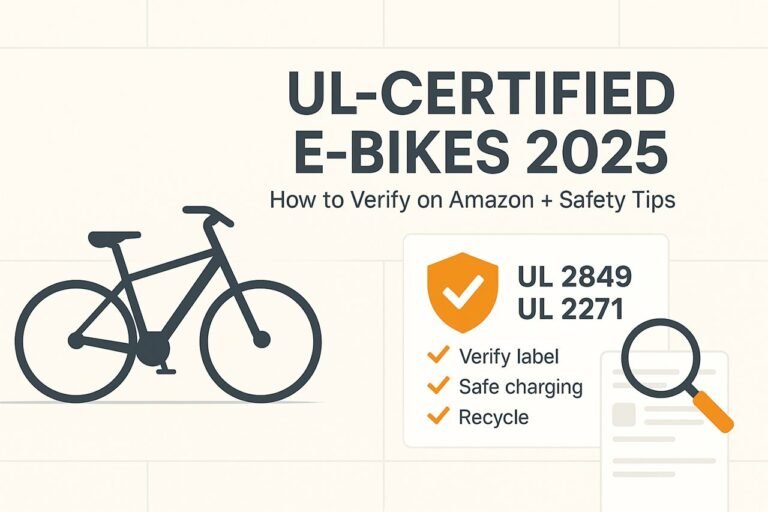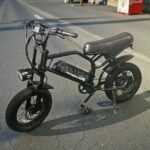
Adjusting e-bike suspension might sound complex, but it’s an important part of keeping your ride smooth, safe, and fun. Many people wonder how to get their e-bike’s suspension just right for their weight, riding style, and the trails ahead.
To adjust e-bike suspension, you need to set the right air pressure in your fork and shock, dial in the compression and rebound settings, and make sure the suspension compresses the correct amount (known as SAG) when you sit on the bike in your normal riding gear. This helps the suspension absorb bumps and maintain control on different surfaces—check out this step-by-step e-bike suspension setup guide for more on getting these settings just right.
The rest of this article will walk through how to check and change each setting, when to add or release air, and what tools and numbers to look for. Expect clear steps, handy tips, and a few quick lists to help anyone tune their e-bike suspension like a pro.
Understanding E-Bike Suspension Systems
E-bike suspension systems play a big role in making rides smoother, safer, and more enjoyable. The main suspension parts and designs can change how a bike feels on city streets, trails, or bumpy hills.
Key Components Explained
E-bike suspension is made up of a few main parts. The front fork is the most noticeable, sitting right at the front wheel. Many e-bikes also have a rear shock for extra comfort, called full suspension.
- Front Fork: Supports the front wheel and absorbs impacts.
- Stanchions: Tubes that slide in and out for smooth motion.
- Springs (Coil or Air): Absorb bumps and provide cushioning.
- Dampers: Control how fast the suspension compresses and rebounds.
These parts work together to keep tires on the ground, reduce shaking, and help with steering, especially on rough roads. For e-bikes, these suspension components are built sturdier to handle more weight and the extra speed that e-motors provide.
Types of Suspension: Front vs. Full Suspension
There are two common types of e-bike suspension setups: front suspension and full suspension.
Front Suspension (hardtail) e-bikes have only a suspension fork at the front. They’re lighter, cheaper, and easier to maintain. These are great for city riding, paved paths, and basic off-road trails.
Full Suspension e-bikes have a front fork and a rear shock. They absorb impacts both front and back, making them ideal for trail riding, mountain paths, or anywhere with lots of bumps. They are heavier and more expensive, but give the best comfort and control.
| Suspension Type | Best For | Pros | Cons |
|---|---|---|---|
| Front Suspension | Roads, light trails | Lighter, less costly, easier upkeep | Less comfort off-road |
| Full Suspension | Trails, rough terrain | Maximum comfort, better control | Heavier, pricier |
Role of Suspension in E-Bike Performance
Good suspension does more than just soak up bumps. It helps the e-bike keep traction, especially when turning or braking. This is important because e-bikes are heavier than regular bikes and move faster due to the motor.
A well-adjusted suspension system can reduce rider fatigue, prevent wrist and back pain, and make long rides more fun. Stiffer springs or higher tire pressures might be needed for e-bikes to handle extra weight, as suggested by this tip from the Cyrusher Community.
Suspension performance can also affect battery life. If the suspension is too soft, the bike may bounce and waste energy. If it’s too stiff, comfort drops and hands feel every bump. Proper tuning lets riders get the most out of their e-bike, both for daily commutes and off-road adventures.
Essential Pre-Adjustment Factors

Before tweaking any e-bike suspension, it’s important to understand how your weight, the kind of ground you’ll be riding on, and the length of the suspension travel all work together. Skipping these factors can lead to poor comfort, less traction, and unnecessary wear on the bike.
Matching Suspension to Rider Weight
The weight of the rider has a huge impact on how suspension performs. Too much air pressure or a spring that’s too firm can make the ride feel harsh. Not enough, and the bike can feel wobbly or bottom out over bumps.
Most manufacturers offer recommended starting pressures or spring rates for certain weight ranges, usually found on the fork leg or their website. It’s best to use a shock pump to set the correct pressure if you use air suspension. For coil suspension, picking the right spring is key.
Here’s a quick guide:
| Rider Weight (lbs) | Suspension Pressure (psi) |
|---|---|
| 120-150 | 65–85 |
| 150-180 | 85–105 |
| 180-210 | 105–125 |
| 210+ | 125+ |
Checking these numbers helps prevent both sagging and harshness. Always adjust the pressure with your body weight on the bike for accuracy. The right setup keeps the ride balanced and safer.
Impact of Terrain and Riding Style
Terrain and riding style change how suspension should be adjusted. Rocky or root-filled trails need a softer, more active suspension, while smooth city paths do better with firmer settings. Downhill riders use softer setups for control, but road riders prefer stiffer suspension for better speed.
Think about where and how you plan to ride most. Steep or bumpy trails demand more comfort and grip, so riders tend to use more sag and less rebound damping. Jumping or aggressive downhill riding means setting things up softer but controlled. Commuting or smooth trails? Add stiffness to boost efficiency.
A simple list for fast setup:
- Urban/flat terrain: Higher pressure, stiffer feel
- Off-road/rough terrain: Lower pressure, more sag
- Aggressive/downhill: Softer, but more rebound control
Adjust these settings every time your typical terrain changes for the best experience.
Suspension Travel and Its Importance
Suspension travel measures how far the fork or shock can compress, usually shown in millimeters. This affects how the bike handles rough roads, jumps, and drops. E-bikes often have travel from 80mm (short urban rides) up to 150mm or more (mountain biking).
Here’s what the numbers mean:
| Suspension Travel (mm) | Best Use |
|---|---|
| 80–100 | City, commuting, smooth paths |
| 120–150 | Trail, mixed surfaces |
| 150+ | Downhill, aggressive trails |
More travel helps absorb bigger bumps and keeps tires touching the ground. Less travel means a lighter, more efficient ride over flat roads. Riders should match the amount of travel to their favorite types of rides for better comfort, safety, and speed.
Adjusting suspension travel isn’t always possible without changing parts, but knowing your limits can help you ride smarter and avoid damage. For further reading, this step-by-step e-bike suspension setup guide offers practical advice.
Step-by-Step Guide: Adjusting Your E-Bike Suspension
Getting your e-bike suspension dialed means matching air pressure to your weight, measuring sag for the perfect balance, and fine-tuning rebound and compression for smooth control. Small changes can dramatically boost comfort, traction, and bike handling.
Setting Air Pressure Correctly
Air pressure in your suspension fork and rear shock makes a huge difference in performance. Riders should always start by checking the manufacturer’s recommended pressure, usually found on the fork itself or on the company’s website. This value is based on your ride weight, so grab your gear—yes, helmet, backpack, snacks, all of it.
To make this easy, here’s a quick process:
- Grab a dedicated shock pump (not a tire pump).
- Set all suspension settings to “open” or “descend.”
- Inflate fork and shock to the suggested pressure.
- Sit gently on the bike and see how it feels.
Remember, pressure can always be tweaked based on sag and feel. Be patient and adjust in small increments—usually 5-10 psi at a time—to avoid going overboard. Following this helps prevent bottoming out or having a suspension that feels too stiff.
Sample Recommended Air Pressures by Rider Weight
| Rider Weight (kg) | Air Pressure (psi) |
|---|---|
| 60-70 | 70-80 |
| 70-80 | 80-95 |
| 80-90 | 95-110 |
| 90-100 | 110-125 |
Check your brand’s chart for specifics.
How to Measure and Adjust Sag
Sag is the amount your suspension compresses when you’re on the bike. It’s key for keeping tires glued to the ground and handling rough trails. Most riders aim for 20% sag on the fork and 30% on the rear shock.
To measure sag:
- Put on your full riding kit.
- Get on your bike and stand in your usual attack position.
- Have a friend slide the rubber O-ring down to the wiper seal on both fork and shock.
- Carefully get off, and measure how far the O-ring has moved.
Calculate the sag percentage by dividing this movement by total available travel, then multiply by 100.
If the fork or shock sags too much, add air in small steps. If there’s not enough sag, let air out in 5-10 psi increments.
Get detailed instructions and tips from this step-by-step sag setup guide.
Fine-Tuning Rebound and Compression Damping
Once air pressure and sag are set, shift focus to damping settings. Rebound damping controls how quickly the suspension returns after a bump, while compression damping manages how it soaks up impacts.
Start with all damping adjusters at their midpoint. Take the bike for a short test ride over mixed terrain.
- Too fast rebound? Bike feels bouncy, difficult to control after hits. Add rebound damping (turn knob toward “+”).
- Too slow rebound? Suspension feels sluggish or “packs down” after repeated bumps. Reduce rebound damping (turn knob toward “-”).
Compression damping is great for riders who pedal hard or ride rocky trails. Increase damping for less fork “dive” or rear-end “squat.” Back it off for smoother, plush feel on bumpy terrain.
Each bike and rider is different, so experiment and adjust until things feel just right. Consistent tweaks can make handling much sharper and riding much more fun.
Advanced Tuning Tips for Ultimate Comfort
Getting an e-bike to feel just right can take some fine-tuning. Riders often seek smoother suspension and less jarring impacts, especially on uneven paths or trails.
Dialing in Volume Spacers
Volume spacers are small inserts placed inside the air chamber of a suspension fork or shock. They change the amount of air space, which helps control how quickly the suspension ramps up under pressure. More spacers make the suspension firmer at the end of its travel, reducing bottom-outs. Fewer spacers make it feel softer.
Installing or removing spacers can often be done at home with basic tools, but always check the manufacturer’s instructions for the exact process. Most e-bikes use 2-5 spacers, depending on rider weight and terrain.
Quick Steps:
- Deflate the suspension first
- Open the air can
- Add or remove spacers as needed
- Reassemble and inflate to the right pressure
This simple tweak changes the entire suspension feel. A table comparing typical spacer setups:
| Spacers | Ride Feel | Good For |
|---|---|---|
| 1-2 | Softer, plush | Smooth trails, comfort |
| 3-4 | Supportive, firm | Rocky/steep terrains |
| 5+ | Very firm, progressive | Heavy riders/aggressive== |
Adjusting Bottom-Out Resistance
Bottom-out resistance keeps the suspension from slamming through all its travel. With e-bikes being heavier, getting this right prevents harsh impacts that could damage the fork or shock.
Many modern shocks let riders adjust bottom-out with external dials or by changing air pressure. The key facts:
- Increase air pressure for more resistance
- Add tokens or bumpers inside the shock for a firmer stop
- Use the external low-speed compression dial if available
Always adjust a bit at a time. Go for a test ride and listen for banging noises or harsh stops. If these happen often, add resistance. If the ride feels too stiff, reduce it slightly.
Proper bottom-out tuning makes suspension feel safer and more comfortable, especially for heavier riders or rougher trails. For technical details, check Fox’s tuning guides.
Maintenance and Longevity of Your Suspension

Keeping e-bike suspension in top shape helps avoid costly repairs and makes rides smoother. Simple habits like regular cleaning and checking for wear go a long way to prevent breakdowns and keep performance high.
Inspecting and Cleaning Suspension Components
E-bike riders should inspect their suspension components often. Dirt, mud, and tiny rocks can build up on the stanchions and seals. This buildup can scratch moving parts or make them stick. Always wipe down the stanchions with a soft, damp cloth after every muddy ride.
Look for any oil leaking from forks or rear shocks. Leaks mean seals could be failing. Make sure the stanchions look shiny and are free from deep scratches or rust. If there’s dirt stuck under the seals, use a soft brush to clean it out gently.
Here’s a quick cleaning checklist:
- Wipe off stanchions after rides
- Check for oil, scratches, or rust
- Clean seals and dust wipers
- Avoid spraying water directly at seals
These steps keep suspension components working smoothly, reducing the chance of expensive problems down the road.
Regular Suspension Checks for Continued Performance
Regular checks help catch small issues before they mess with suspension performance. It’s smart to compress the fork or rear shock by hand once a week. If movement feels rough or sticky, there may be dirt inside, or parts may need fresh grease.
Check for loose bolts at the shock mounts and pivots using a torque wrench. Tighten to the manufacturer’s recommended values. Pay attention if you hear new noises, like squeaking or clunking; those usually mean it’s time for a closer look.
A table can help keep track:
| Task | How Often | What to Look For |
|---|---|---|
| Compress Suspension | Weekly | Smooth, quiet movement |
| Inspect Bolts | Monthly | Tight, no play or wobbles |
| Check for Leaks | After rides | Oil on stanchions or frame |
A little maintenance sticks with the bike for thousands of miles. Most e-bike users can handle these regular checks at home, and they’re a lot cheaper than new forks or rear shocks!
Final Thoughts on Adjusting E-Bike Suspension
Adjusting e-bike suspension isn’t rocket science, but it does require paying attention to some important details. Riders who set their suspension right notice a smoother, more controlled ride and less fatigue during longer rides.
A handy checklist for e-bike suspension tuning includes:
- Check weight settings to match the bike’s heavier frame.
- Set the correct SAG: 20% for the fork, 30% for the rear shock—measured as a percentage of total travel.
- Always use the right gear during setup, including helmet and backpack.
- Revisit your settings after a few rides and make small tweaks.
Knowing the proper steps, such as setting SAG with an assistant and air pump, makes a big difference. It’s also smart to use step-by-step guides to avoid missing key steps.
Getting suspension dialed in lets riders enjoy their e-bike to the fullest. Extra comfort, better traction, and more confidence on every trail—they’re all possible with a little patience and the right adjustments.











